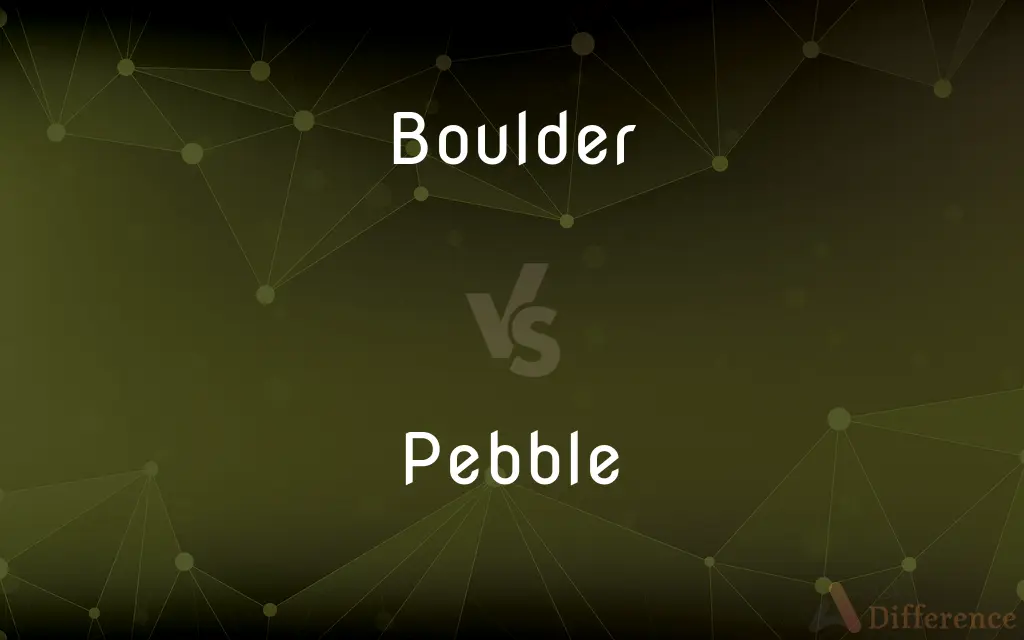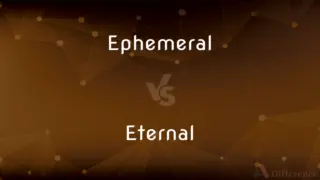Boulder vs. Pebble — What's the Difference?
Edited by Tayyaba Rehman — By Fiza Rafique — Updated on April 3, 2024
A boulder is a large rock, often too big to be moved by hand, formed by geological processes, while a pebble is a small, smooth stone shaped by the action of water or sand.

Difference Between Boulder and Pebble
Table of Contents
ADVERTISEMENT
Key Differences
Boulders are large rocks, typically over 256 millimeters in diameter, found in various landscapes. They are often too heavy to be moved without mechanical assistance. In contrast, pebbles are much smaller, usually ranging from 2 to 64 millimeters in diameter, and can easily be held in the hand. Pebbles are often found on beaches and riverbeds, their smooth texture a result of prolonged water erosion.
The formation of boulders can result from geological processes such as volcanic activity, erosion of larger rock formations, or as glacial deposits. Pebbles, on the other hand, are usually formed by the weathering and erosion of larger rocks, which are then smoothed over time by flowing water or the movement of waves.
Boulders, due to their size and weight, are often used in landscaping, as natural barriers, or as artistic elements in gardens and parks. Pebbles are used decoratively as well, in garden paths, aquariums, and as aggregate in construction.
The composition of a boulder can vary widely, from granite and sandstone to basalt and quartzite, reflecting the local geology where they are found. Pebbles, while also varied in composition, are often identified by their smoothness and rounded shape rather than their mineral content.
Boulders can serve as habitats or shelters for various forms of life, including mosses, lichens, and small animals. Pebbles, while not providing shelter, contribute to the habitat of aquatic and shoreline ecosystems, supporting microhabitats for insects and small aquatic creatures.
ADVERTISEMENT
Comparison Chart
Size
Typically over 256 mm in diameter
Ranges from 2 to 64 mm in diameter
Formation
Geological processes, erosion, volcanic activity
Weathering and erosion, smoothed by water
Common Locations
Landscapes, glacial areas
Beaches, riverbeds
Uses
Landscaping, barriers, artistic elements
Decorative paths, aquariums, construction
Composition
Varied, reflects local geology
Varied, often identified by smoothness and shape
Compare with Definitions
Boulder
Their size and composition vary widely.
The boulder was composed of a dense, dark basalt.
Pebble
Often used decoratively in gardens and aquariums.
The pathway was lined with white pebbles for a striking contrast.
Boulder
A large, often immovable rock formed through geological processes.
The garden's design featured a massive boulder as its centerpiece.
Pebble
Their formation is a result of the weathering of larger rocks.
Over millennia, water transformed the rock into smooth pebbles.
Boulder
Commonly found in a variety of landscapes and used for structural purposes.
Boulders were strategically placed along the shore to prevent erosion.
Pebble
A small, smooth stone polished by natural forces like water or sand.
She collected colorful pebbles from the beach as souvenirs.
Boulder
Can provide habitats for a range of organisms.
Moss and lichens thrived on the shaded side of the boulder.
Pebble
Contributes to the habitat of aquatic ecosystems.
Aquatic insects darted among the pebbles in the clear stream.
Boulder
Integral to certain ecosystems and landscapes.
Glacial boulders dot the landscape, left behind by retreating ice ages.
Pebble
Can be found in a wide range of environments.
Pebbles of varying shades of grey littered the riverbed.
Boulder
In geology (Udden–Wentworth scale), a boulder is a rock fragment with size greater than 256 millimetres (10.1 in) in diameter. Smaller pieces are called cobbles and pebbles.
Pebble
A pebble is a clast of rock with a particle size of 4–64 mm (0.16–2.52 in) based on the Udden-Wentworth scale of sedimentology. Pebbles are generally considered larger than granules (2–4 mm (0.079–0.157 in) in diameter) and smaller than cobbles (64–256 mm (2.5–10.1 in) in diameter).
Boulder
A large rounded mass of rock lying on the surface of the ground or embedded in the soil.
Pebble
A small stone, especially one worn smooth by erosion.
Boulder
A large mass of stone detached from the surrounding land.
Pebble
Clear colorless quartz; rock crystal.
Boulder
(geology) A particle greater than 256 mm in diameter, following the Wentworth scale
Pebble
A lens made of such quartz.
Boulder
A large marble, in children's games.
Pebble
(Geology) A rock fragment between 4 and 64 millimeters (0.16 and 2.51 inches) in diameter, especially one that has been naturally rounded.
Boulder
(climbing) A session of bouldering; involvement in bouldering.
Pebble
An irregularly rough, grainy surface, as on leather or paper.
Boulder
To engage in bouldering.
Pebble
To pave with pebbles.
Boulder
Same as Bowlder.
Pebble
To impart an irregularly rough, grainy surface to (leather or paper).
Boulder
A large smooth mass of rock detached from its place of origin
Pebble
To pelt with pebbles.
Boulder
A town in north central Colorado; Rocky Mountains resort center and university town
Pebble
A small stone, especially one rounded by the action of water.
Pebble
(geology) A particle from 4 to 64 mm in diameter, following the Wentworth scale.
Pebble
(curling) A small droplet of water intentionally sprayed on the ice that cause irregularities on the surface.
Pebble
Transparent and colourless rock crystal.
Brazilian pebble
Pebble
A form of slow-burning gunpowder in large cubical grains.
Pebble
(transitive) To pave with pebbles.
Pebble
To deposit water droplets on the ice.
To pebble the ice between games
Pebble
(transitive) To give (leather) a rough appearance with small rounded prominences.
Pebble
To place a pebble at (a vertex of a graph) according to certain rules; see pebble game.
Pebble
A small roundish piece of stone; especially, a stone worn and rounded by the action of water; a pebblestone.
As children gathering pebbles on the shore.
Pebble
Transparent and colorless rock crystal; as, Brazilian pebble; - so called by opticians.
Pebble
To grain (leather) so as to produce a surface covered with small rounded prominences.
Pebble
A small smooth rounded rock
Common Curiosities
What are some common uses for boulders and pebbles?
Boulders are used in landscaping and as natural barriers, while pebbles are used decoratively in gardens, paths, and in construction materials.
Can the size of a pebble vary?
Yes, pebbles can vary in size but are generally classified as being from 2 to 64 millimeters in diameter.
How are pebbles formed?
Pebbles are formed by the weathering and erosion of larger rocks, smoothed over time by water or sand.
Do boulders and pebbles have ecological roles?
Yes, boulders can provide habitats or shelters for various organisms, while pebbles contribute to aquatic and shoreline ecosystems.
What distinguishes a boulder from a pebble?
Size and formation processes distinguish boulders from pebbles, with boulders being significantly larger and formed from different geological activities.
How do boulders affect the landscape?
Boulders can impact the landscape by serving as natural barriers, influencing soil formation, and creating microhabitats for plants and animals.
Are all pebbles found near water?
While many pebbles are formed and found near water, they can also be found in other environments, including deserts and on mountain paths.
Where can boulders be typically found?
Boulders can be found in a variety of landscapes, including mountainous regions, glacial deposits, and as part of geological formations.
Why are pebbles smooth?
Pebbles are smoothed by the continuous movement of water or sand, which erodes their surface over time.
Can the composition of a boulder indicate its origin?
Yes, the mineral composition and structure of a boulder can provide clues about its geological origin and the processes it has undergone.
What is the significance of boulders in cultural or historical contexts?
In many cultures, boulders have served as landmarks, spiritual symbols, and in megalithic structures, reflecting their importance throughout human history.
Are boulders and pebbles made of the same materials?
Both can be composed of a variety of minerals but are often categorized by size and shape rather than composition.
Is there a specific term for a rock between the size of a boulder and a pebble?
Rocks between the sizes of boulders and pebbles can be referred to as cobbles or stones, depending on their diameter.
How do human activities impact boulders and pebbles?
Human activities, such as construction and landscaping, can relocate and use these rocks, altering natural landscapes and potentially impacting local ecosystems.
How long does it take for a pebble to form?
The formation of a pebble can take thousands to millions of years, depending on environmental conditions and the type of parent rock.
Share Your Discovery

Previous Comparison
Squab vs. Sofa
Next Comparison
Ephemeral vs. EternalAuthor Spotlight
Written by
Fiza RafiqueFiza Rafique is a skilled content writer at AskDifference.com, where she meticulously refines and enhances written pieces. Drawing from her vast editorial expertise, Fiza ensures clarity, accuracy, and precision in every article. Passionate about language, she continually seeks to elevate the quality of content for readers worldwide.
Edited by
Tayyaba RehmanTayyaba Rehman is a distinguished writer, currently serving as a primary contributor to askdifference.com. As a researcher in semantics and etymology, Tayyaba's passion for the complexity of languages and their distinctions has found a perfect home on the platform. Tayyaba delves into the intricacies of language, distinguishing between commonly confused words and phrases, thereby providing clarity for readers worldwide.














































